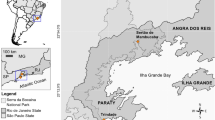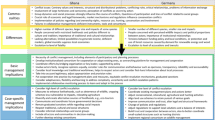Abstract
Management of conservation conflicts is a challenge of growing relevance for the effectiveness of protected areas worldwide, particularly in the case of socially inclusive areas such as biosphere reserves. For a successful management of the protected area, is critical to consider the social use of natural resources carried out by local populations linked to reserves, especially in socio-ecological contexts facing potential conservation conflicts (i.e., conflicts that have not yet arisen). We addressed the importance of an early detection of potential conflicts through the study of artisanal charcoal production by Yucatec Mayan communities located in the zone of influence of a biosphere reserve in Northwest Yucatan Peninsula, Mexico. Through semi-structured interviews with charcoal producers and in-depth interviews with environmental authorities linked to the reserve, we discuss the advantages associated to early detection of potential conservation conflicts for biosphere reserves’ management.



Similar content being viewed by others
References
Anaya FC, Espírito-Santo MM (2018) Protected areas and territorial exclusion of traditional communities: analyzing the social impacts of environmental compensation strategies in Brazil. Ecol Soc 23(1):8
Arrocha F, Villena MG (2012) Applying a bioeconomic optimal control model to charcoal production: the case of slash-and-burn agriculture in Mexico. Cienc Investig Agra 39(3):489–504
Barrera-Bassols N, Toledo V (2005) Ethnoecology of the Yucatec Maya: symbolism, knowledge and management of natural resources. J Lat Am Geogr 4:9–41
Baynham-Herd Z, Redpath S, Bunnefeld N, Molony T, Keane (2018) Conservation conflicts: Behavioural threats, frames, and intervention recommendations. Biol Conserv 222:180–188
Bennet NJ, Dearden P (2014) Why local people do not support conservation: Community perceptions of marine protected area livelihood impacts, governance and management in Thailand. Mar Policy 44:107–116
Bouamrane M, Spierenburg M, Agrawal A, Boureima A, Cormier-Salem MC, Etienne M, Le Page C, Levrel H, Mathevet R (2016) Stakeholder engagement and biodiversity conservation challenges in social-ecological systems: some insights from biosphere reserves in western Africa and France. Ecol Soc 21(4):25
Brown DF (2007) The spatial and temporal dimensions of a rural landscape: the Yucatec Maya k’ax. The Canadian Geographer / Le Geographe canadien 51(1):91–108
Carmen E, Young JC, Watt A (2015) Linking conflict and global biodiversity conservation policies. In: Redpath SM, Gutiérrez RJ, Wood KA, Young JC (Eds) Conflicts in conservation. Navigating towards solutions. Cambridge University Press, Cambridge, United Kingdom, pp 180–189
CCMSS (2008) Tramitología: un fuerte obstáculo para el sector forestal de México. Nota Informativa Número 19 Red De Monitoreo De Políticas Públicas – CCMSS JUNIO
CONANP (2006) Programa de Conservación y Manejo. Reserva de la Biósfera Los Petenes. Comisión Nacional de Áreas Naturales Protegidas, Campeche, México
Cooper NA, Kainer KA (2018) To log or not to log: local perceptions of timber management and its implications for wellbeing within a sustainable-use protected area. Ecol Soc 23(2):4
Dawson N, Martin A, Danielsen F (2018) Assessing equity in protected area governance: approaches to promote just and effective conservation. Conserv Lett 11(2):1–8
De Pourcq K, Thomas E, Arts B, Vranckxa A, Leónn-Sicard T, Van Damme P (2017) Understanding and resolving conflict between local communities and conservation authorities in Colombia. World Dev 93:125–135
Durand L, Figueroa F, Trench T (2015) Inclusión, exclusión y estrategias de participación en la reserva de la biosfera Montes Azules (Chiapas). In: Durand L, Figueroa F, Guzmán M (Eds) La naturaleza en contexto. Hacia una ecología política mexicana. Colección Alternativas
Eastmond A, Faust B (2006) Farmers, fires, and forests: a green alternative to shifting cultivation for conservation of the Maya forest? Landscape and Urban Planning 74:267–284
FAO (2018) El estado de los bosques del mundo - Las vías forestales hacia el desarrollo sostenible. Roma. Licencia: CC BY-NC-SA 3.0 IGO
Flores JS, Espejel I (1994) Etnoflora Yucatanense. Tipos de Vegetación de la Península de Yucatán. Fasc. No. 4. Lic. en Biología. Facultad de Medicina Veterinaria y Zootecnia, Universidad Autónoma de Yucatán, Mérida
García-Frapolli E, Ayala-Orozco B, Oliva M, Smith RJ (2018) Different approaches towards the understanding of socio-environmental conflicts in protected areas. Sustainability 10:2240
García-Frapolli E, Ramos-Fernández G, Galicia E, Serrano A (2009) The complex reality of biodiversity conservation through Natural Protected Area policy: three cases from the Yucatan Peninsula, Mexico. Land Use Policy 26:715–722
Gardner CJ, Gabriel FUL, ST. JOHN FAV, Davies ZG (2016) Changing livelihoods and protected area management: a case study of charcoal production un south-west Madagascar. Oryx 50(3):495–505
Gerez-Fernández P, Alatorre-Guzmán E (2007) Los retos de la certificación forestal en la silvicultura comunitaria de México. In: Bray DB, Merino-Pérez L, Barry D (Eds) Los bosques comunitarios de México Manejo sustentable de paisajes forestales. Instituto Nacional de Ecología (INE-Semarnat), pp 99–120
Haenn N (2006) The changing and enduring ejido: a state and regional examination of Mexico’s land tenure counter-reforms. Land Use Policy 23(2):136–146
Halffter G (2011) Reservas de la biosfera: problemas y oportunidades en México. Acta Zoológica Mexicana 27(1):177–189
INEGI (1997) Plano producido para el Registro Agrario Nacional. Ejido “Los Petenes”, Clave 001
INEGI (2010) Censo de Población y Vivienda 2010. http://www3.inegi.org.mx/sistemas/iter/entidad_indicador.aspx?ev=5. Accessed 17 Apr 2016
Jerneck A, Olsson L, Ness B, Anderberg S, Baier M, Clark E, Hickler T, Hornborg A, Kronsell A, Lövbrand E, Persson J (2011) Structuring sustainability science. Sustain Sci 6:69–82
Kefa CA, Lung M, Espira A, Gregory AJ (2018) Quantifying the rate of subsistence wood harvesting from a tropical rainforest in Kenya. Oryx 52(2):369–373
León P, Montiel S (2008) Wild meat use and traditional hunting practices in a rural Mayan community of the Yucatan Peninsula, Mexico. Hum Ecol 36:249–257
Lewis C (1996) Managing Conflicts in Protected Areas. International Union for Conservation of Nature (IUCN), Gland, Switzerland
LGDFS (2018) Ley General de Desarrollo Forestal Sustentable No. – (05 de Junio). http://www.diputados.gob.mx/LeyesBiblio/pdf/LGDFS_050618.pdf. Accessed 3 Jul 2018
LGDFS for the state of Campeche (2018) Ley General de Desarrollo Forestal Sustentable para el Estado de Campeche No. – (12 de Abril). http://legislacion.congresocam.gob.mx/images/legislacion/leyes/pdf/ley_de_desarrollo_forestal_sustentable_para_el_estado_de_campeche.pdf. Accessed 3 Jul 2018
Lu DJ, Kao CW, Chao CL (2012) Evaluating the management effectiveness of five protected areas in Taiwan using WWF’s RAPPAM. Environ Manage 50:272–282
Madden F, McQuinn B (2015) Conservation conflict transformation: the missing link in conservation. In: Redpath SM, Gutiérrez RJ, Wood KA, Young JC (Eds) Conflicts in conservation. Navigating towards solutions. Cambridge University Press, Cambridge, United Kingdom, pp 257–267
Martín-López B, Montes C (2015) Restoring the human capacity for conserving biodiversity: a social-ecological approach. Sustain Sci 10:699–706
Meijboom FLB, Brom FWA (2012) Ethics and sustainability: guest or guide? On sustainability as a moral idea. J Agric Environ Ethics 25:117–121
Méndez-López ME, García-Frapolli E, Ruiz-Mallén I, Porter-Bolland L, Reyes-García V (2015) From paper to forest: local motives for participation in different conservation initiatives. Case Studies in Southeastern Mexico. Environ Manage 56:695–708
Merino-Pérez L (2013) Conservation and Forest Communities in Mexico: Experiences, Visions, and Rights. In: Porter-Bolland L, Ruiz-Mallen I, Camacho-Benavides C, McCandless SR (Eds) Community Action for Conservation: Mexican Experiences. Springer Science+Business Media, New York, NY, p 25–44
Mohibbi AA, Cochard R (2014) Residents’ resource uses and nature conservation in Band-e-Amir National Park, Afghanistan. Environ Dev 11:141–161
Newing H (2011) Conducting Research in Conservation. A Social Science perspective. Ed. Routlegde, New York, NY
NOM-059 (2001) Norma Oficial Mexicana NOM-059-ECOL-2001, Protección ambiental-Especies nativas de México de flora y fauna silvestres-Categorías de riesgo y especificaciones para su inclusión, exclusión o cambio-Lista de especies en riesgo (2001). No. – (6 de Marzo de 2002). http://www.profepa.gob.mx/innovaportal/file/435/1/NOM_059_SEMARNAT_2010.pdf. Accessed 3 Jul 2018
Oliva M, Montiel S (2016) Stakeholder linkage in conservation strategies: a qualitative tool for improving the management of a biosphere reserve in the Yucatan Peninsula, Mexico. Trop Conserv Sci 9(1):423–438
Oliva M, Montiel S, García A, Vidal L (2014) Local perceptions of wildlife use in Los Petenes Biosphere Reserve, Mexico: Maya subsistence hunting in a conservation conflict context. Trop Conserv Sci 7(4):781–795
Redpath SM, Sutherland WJ (2015) The value of ecological information in conservation conflict. In: Redpath SM, Gutiérrez RJ, Wood KA, Young JC (Eds) Conflicts in conservation. Navigating towards solutions. Cambridge University Press, Cambridge, United Kingdom, pp 35–45
Redpath SM, Gutiérrez RJ, Wood KA, Young JC (2015) Finding a way out of conservation conflicts. In: Redpath SM, Gutiérrez RJ, Wood KA, Young JC (Eds) Conflicts in conservation. Navigating towards solutions. Cambridge University Press, Cambridge, United Kingdom, pp 287–300
Redpath SM, Young J, Evely A, Adams WM, Sutherland WJ, Whitehouse A, Amar A, Lambert RA, Linnell JDC, Watt A, Gutiérrez RJ (2013) Understanding and managing conservation conflicts. Trends Ecol Evolut 28(2):100–109
Reed MS (2008) Stakeholder participation for environmental management: A literature review. Biol Conserv 141:2417–2431
Regulation LGDFS (2005) Reglamento de la Ley General de Desarrollo Forestal Sustentable No. – (21 de Febrero). Accessed 3 July 2018.
Robinson JG (2011) Ethical pluralism, pragmatism, and sustainability in conservation practice. Biol Conserv 144:958–965
Rodríguez M, Montiel S, Cervera MD, Castillo MT, Naranjo EJ (2012) The practice and perception of batida (group hunting) in a maya community of Yucatan, Mexico. J Ethnobiol 32(2):212–227
Román-Dañobeytia FJ, Levy-Tacher SI, Macario-Mendoza P, Zúñiga-Morales J (2014) Redefining secondary forests in the Mexican forest code: implications for management, restoration, and conservation. Forests 5:978–991
Smith HE, Hudson MD, Schreckenberg K (2017) Livelihood diversification: The role of charcoal production in southern Malawi. Energy Sustain Dev 36:22–36
Soliku O, Schraml U (2018a) Making sense of protected area conflicts and management approaches: a review of causes, contexts and conflict management strategies. Biol Conserv 222:136–145
Soliku O, Schraml U (2018b) From conflict to collaboration: the contribution of co-management in mitigating conflicts in Mole National Park, Ghana. Oryx 1–11. https://doi.org/10.1017/S0030605318000285
UNESCO (1996) Reservas de biosfera: La Estrategia de Sevilla y el Marco Estatutario de la Red Mundial. UNESCO, París
UNESCO (2014) Biosphere Reserves – Learning Sites for Sustainable Development. http://www.unesco.org/new/en/natural-sciences/environment/ecological-sciences/biosphere-reserves/. Accessed 5 Sept 2018
Van Cuong C, Dart P, Hockings M (2017) Biosphere reserves: attributes for success. J Environ Manage 188:9–17
Wali A, Alvira D, Tallman PS, Ravikumar A, Macedo MO (2017) A new approach to conservation: using community empowerment for sustainable well-being. Ecol Soc 22(4):6
Whitehouse A (2015) Anthropological approaches to conservation conflicts. In: Redpath SM, Gutiérrez RJ, Wood KA, Young JC (Eds) Conflicts in conservation. Navigating towards solutions. Cambridge University Press. pp 94–104
Wolf F, Vogel E (1985) Manual para la producción de carbón vegetal con métodos simples. Facultad de Silvicultura y manejo de recursos renovables. Universidad Autónoma de Nuevo León
Woodhouse E, Homewood KM, Beauchamp E, Clements T, McCabe JT, Wilkie D, Milner-Gulland EJ (2015) Guiding principles for evaluating the impacts of conservation interventions on human well-being. Phil Trans R Soc B 370:20150103
Young JC, Thompson DBA, Moore P, MacGugan A, Watt A, Redpath SM (2016a) A conflict management tool for conservation agencies. J Appl Ecol 53:705–711
Young JC, Searle K, Butler A, Simmons P, Watt AD, Jordan A (2016b) The role of trust in the resolution of conservation conflicts. Biol Conserv 195:196–202
Acknowledgements
The first author extends acknowledgment to the PhD Program in Sustainability Sciences, UNAM “Doctorado en Ciencias de la Sostenibilidad, Universidad Nacional Autónoma de México”, and a PhD scholarship received from CONACYT, Mexico. This research was funded by UNAM—PAPIIT, grant number IN302517. We are very grateful to the people who participated and shared valuable information for this study. We thank Mary Ann Hall for the English language revision.
Author information
Authors and Affiliations
Corresponding author
Ethics declarations
Conflicts of Interest
The authors declare that they have no conflict of interest.
Additional information
Publisher’s note: Springer Nature remains neutral with regard to jurisdictional claims in published maps and institutional affiliations.
Rights and permissions
About this article
Cite this article
Oliva, M., García-Frapolli, E., Porter-Bolland, L. et al. Early Detection of Conflicts for the Management of Protected Areas: The Case of Charcoal Production in the Los Petenes Biosphere Reserve, Mexico. Environmental Management 64, 52–63 (2019). https://doi.org/10.1007/s00267-019-01170-x
Received:
Accepted:
Published:
Issue Date:
DOI: https://doi.org/10.1007/s00267-019-01170-x




